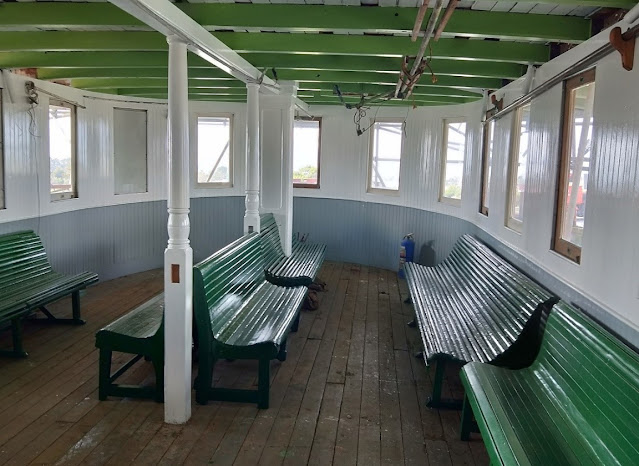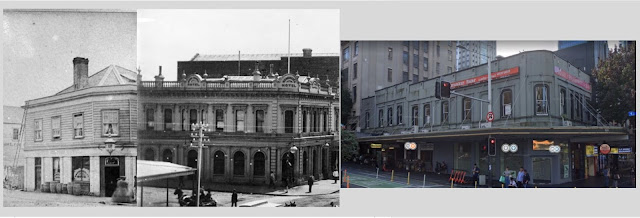The steam ferry Toroa on the Waitematā harbour, 1950s. Auckland Libraries Heritage Collections T0470
(Guest post from the Toroa Preservation Society)
A brief outline of the history of Auckland’s last surviving steam ferry, and a resume of the restoration work to date. For more detailed information visit www.steamferrytoroa.com
Built and launched in Auckland in 1925, the Toroa was the last of the wooden-planked double-ended ferries. She remained in service until 1980 when her survey certificate expired. There were eight ferries of this type, specifically designed for quick travel between relatively close destinations. The double-ended arrangement with a propeller and wheelhouse at bow and stern saved manoeuvring at each wharf or jetty. The fate of each of these vessels was as follows:
Albatross (1904) Diesel conversion 1952 Laid up 1959 Broken up 1968
Kestrel (1905) Diesel conversion 1951 Refit 1982
To Tauranga as floating restaurant 2002
Return to Auckland 2010
Sank at mooring 2016 |
Broken up 2022
Pupuke (1909) Laid up 1959 Beached Ponui island 1962 and broken up
The Peregrine (1912)
Laid up 1959 Buried at Westhaven 1981
Ngoiro (1913) Laid up 1959 Restaurant in Viaduct 1982
To Tairua 1999 where she sits in a backfilled sand berth
Makora (1921) Laid up 1974 Buried at Westhaven 1981
Takapuna (1924) Laid up 1967 Buried at Westhaven 1981
Toroa (1925) Laid up 1980 Under restoration
Return to Auckland 2010
Sank at mooring 2016 |
Broken up 2022
Pupuke (1909) Laid up 1959 Beached Ponui island 1962 and broken up
The Peregrine (1912)
Laid up 1959 Buried at Westhaven 1981
Ngoiro (1913) Laid up 1959 Restaurant in Viaduct 1982
To Tairua 1999 where she sits in a backfilled sand berth
Makora (1921) Laid up 1974 Buried at Westhaven 1981
Takapuna (1924) Laid up 1967 Buried at Westhaven 1981
Toroa (1925) Laid up 1980 Under restoration
Proposals to save at least one of these iconic ferries eventually resulted in the Toroa Preservation Society being established in 1985 at the instigation of Jim Mason of the New Zealand Maritime Trust. This group, with the intention of returning an operational historic steam excursion ferry to the Waitemata Harbour, continues today with one or two early members still involved. A floating restaurant has never been part of the plan.
Built at St Mary’s Bay at the yard of George Niccol, the Toroa was, unlike the first of this design, of composite construction. This means the ferry has steel frames and bulkheads giving shape and strength to the timber planked hull. This method of construction was used for a time in ship building when all the nearby timber had been used and large baulks became expensive due to transport costs. It was also found that a composite hull gave more internal space for cargo and machinery due to steel or iron frames being smaller than the timber equivalent.
Toroa’s triple-expansion steam engine and coal-fired boiler remained in use all her working life. Other ferries were converted to diesel because their compound steam engines were of less power and efficiency. A stoker was also not needed on a diesel ferry so labour costs were reduced. It is most unlikely that coal will fuel the Toroa in the future and alternatives are being explored.
If the Toroa had been slipped and repaired to meet survey requirements in the 1980s then the subsequent history would have been different. As it is today, time on a large commercial slipway was then costly, and unknown costs and timeframe meant this did not happen. The machinery, although operating, was tired, at least four ribs in confined spaces needed replacing and all the sheathing would have had to be removed to inspect hull planking. Under pressure from the Auckland Harbour Board, the Preservation Society members maintained Toroa while afloat as best they could, all the time trying to devise a way to carry out major repairs. Berths were made available at the cement wharf and later Birkenhead wharf.
Although Birkenhead wharf was not ideal for shelter from wind and tide, it was good for public exposure. This was a good time for fundraising to cover engineering and superstructure restoration. For a while the TV soap Shortland Street used the ferry as a set, with many activities on board.
To be able to carry out hull repairs a floating dry dock of eight ferro-cement pontoons was professionally designed and built, with the support of New Zealand Lotteries Grants Board and North Shore City Council. In 1998 just as the dry dock was nearing completion, Toroa sank alongside the wharf at night, during a severe storm. The high-water-level alarms and pumps operated but were overcome.
The first attempt at salvage failed and it was a month before success with air bags and floating crane. Damage was extensive, with much of the upper superstructure destroyed by wave action, and corrosion of all steelwork accelerated. The Toroa was slipped and temporary repairs made, while a site was found for the floating dry dock. Approval had been given to site the pontoon system at the western side of Stanley Bay wharf, but after local protest the Devonport Community Board and the Auckland Regional Council reversed their decisions on occupancy and non-notified resource consents. A berth on the eastern side was made available with tight time and fundraising conditions.
During the launching of the last pontoon, contact had been made with Radio New Zealand over submarine cables, and an offer of land at the Selwood Road transmitter site was made. By this time it had become obvious that the dry dock pontoon system was untenable in the inner harbour, so plans began for a land based restoration. The planning, design work and supervision of the hauling out operation was done by society volunteers. It is not known if a larger vessel has been taken from the water anywhere other than on a commercial slipway elsewhere. A search of You Tube under "Toroa Hauling Out" shows a video of the operation.
In December 2001, the Toroa arrived in a very fragile state on a bare gravel site with no buildings or services, let alone working drawings of the ferry. The first few years were spent in the establishment of storage and workshops, along with the major task of accurately measuring the hull. From these measurements, accurate plans were drawn and submitted to a naval architect for modern statutory design approval. Original machinery plans were found in Glasgow archives. Now that the society knew more accurately “what they had” a restoration plan was made and an update to an earlier conservation plan. No planking could be removed at this time due to the very fragile state of the steel framing.
With a grant from the Waitakere Licensing Trust, an order was placed with Dent Steel in England for enough bulb angle to replace all the ribs. Expressions of interest were sought locally for the bending of this bulb angle, but an accurate assessment of costs was not forthcoming. As a result a volunteer resigned from his employment and became a steelwork contractor for several years. Only one or two alternate ribs could be removed at a time and with great ingenuity new ribs were created using local heat and a bending slab from the Navy Dockyard. Some ten thousand rivets were used in the restoration of longitudinal and transverse bulkheads. This work was funded by stage-by-stage grants from NZ Lotteries and the ASB Community Trust. Since the preservation society was founded, the number of individuals who have undertaken the huge and onerous task of these grant applications can be counted on one hand.
New bulb-angle ribs and rivetted bulkheads in the after void of the hull. Photo supplied by Toroa Preservation Society
The ribs had almost all been replaced when an opportunity to purchase large long kauri timber arose. Funds remaining from a steelwork grant were diverted to the purchase of this kauri, enough to replace all major timbers: keel, garboard- and sheer-strakes, and covering boards. More steelwork has been carried out, as always with volunteers acting as labourers to assist skilled contractors. All the new steel main-deck beams are in place and stringer plates at each quarter almost complete. Some planking has been removed and butts in ribs made accessible and now fully welded.
Other than steelwork, both wheelhouses have been restored, cabin walls have been sanded back and painted, and a replacement condenser and boiler located, paid for and transported to site. One forklift has been worn out and a replacement purchased and a band-saw mill for processing large timbers purchased by way of a donation.
The refurbished Ladies Cabin on the main deck. Photo supplied by the Toroa Preservation Society.
Fundraising is ongoing and successful, but the hurdles for heritage funding on a large scale are much higher than in the past. One contributing reason for this is that ‘movable heritage’ is given a low priority in local and national funding guidelines. Some polite lobbying is planned on this front when the time is right. Another requirement is evidence of wide public support, and social media seems to be the best way to gain this. The ‘Likes’ will be counted.
Unfortunately there are sometimes ill-informed and negative comments about a perceived lack of progress, general deterioration or any work being done at all on the restoration. Because all the work to date has been inside Toroa’s hull and not visible from the street, it has been suggested that ‘THEY’ have not been doing anything and nothing is happening. Sure the old planking does not look good, but from early on it became obvious that there was deterioration of the timber around all the fastenings and against the steel ribs, to the point where none can be used as planks again. For most of her time at Selwood Road, there has been a large purpose-made cover over Toroa’s promenade deck, keeping almost all of the weather out. A large roof over the whole ferry was explored but site conditions and cost made this unfeasible.
The vision is to have the Toroa back on the harbour, working as an excursion steamer and providing a link to the vessels that carried millions of passengers and were a large part of Auckland life for over 100 years. There is a limit to what ‘THEY’ can do on their own, so, more than ideas, people are needed to take on the vision and translate the ideas in to actions. And actively help to bring in the essential funding so that the Toroa can steam again.


Toroa passing under the Auckland Harbour Bridge, Waitematā Harbour, 1960s.
Hooker Bowden, Auckland Libraries Heritage Collections D-TWF-0006
Hooker Bowden, Auckland Libraries Heritage Collections D-TWF-0006


















